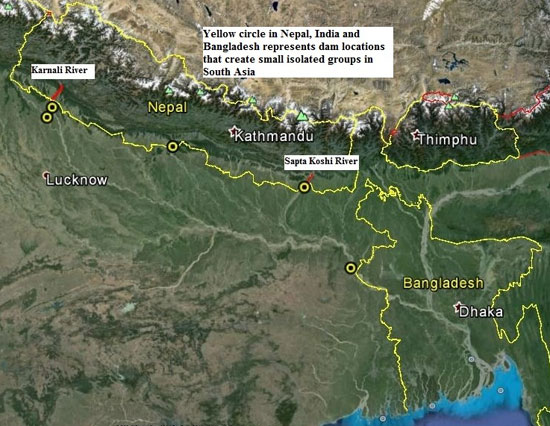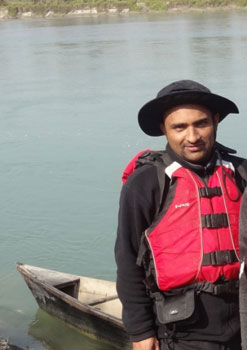Shambhu Paudel
Conservation of the freshwater rivers of Nepal: Endangered dolphins as indicators of river system health
-
Time Period: January 2017 - December 2019
-
Location: Nepal (Karnali, Sapta Koshi, and Narayani river systems)
Project Description & Bio:
Ganges River dolphin, Platanista gangetica gangetic, is the only cetacean species recorded in Nepal. No considerable improvements on population status have been recorded for these small isolated upstream groups (especially in Nepal) in more than two decades, in fact the range of distribution has been reduced significantly as one of the four previously important river systems now have been abandoned and abundance have declined (Smith et al., 1993; Paudel et al., 2015). Less than 30 individuals were counted visually in three river systems of Nepal (Paudel et al., 2015). Large structures like dams, flood-control structures, and embankments for irrigation projects, agriculture and hydroelectric power have impacts on the river dolphins that have led to the loss of longitudinal and lateral connectivity of habitats (Vannote et al., 1980; Ward, 1998; Ward et al., 1999; Dudgeon, 2000; Bunn and Arthington, 2002; Nilsson et al., 2005). As a consequence, clear effects on distribution, gene flow, movement patterns, and behavior have been noticed. At the same time, immense pressure from artisanal fisheries have been documented and two dolphins were entangled in the recent two years (per.obs). Management and maintenance of adequate water flows and ecologically functional habitats is thus the most important challenge for river dolphin conservation in Nepal where only barely viable populations are remaining (Richter et al., 2003; Smakhtin et al., 2007; Paudel et al., 2015). To conserve freshwater ecosystems and their associated critical endangered species, additional research is needed to establish priorities efforts for the conservation and management.

Surfacing river dolphin in Karnali river system of Nepal. Photo: S Paudel
Surfacing river dolphin in Karnali river system of Nepal. Photo: S Paudel
Development of meaningful specific conservation plans for river dolphins is always denied due to lack of data on population status, underwater behavioual patterns (diel activities) and interaction with water flow ecology. Many previous studies (Shrestha, 1989; Smith et al., 1993, Jnawali and Bhuju, 2000; WWF, 2007) have only focused on population abundance estimation using visual counts without detecting observation errors and with only superficial attempts on threats analysis. However, recent studies (Paudel et al., 2014; Paudel et al., 2015; Paudel et al., 2016) have put more emphasis on the cause of the population decline and proposal for solutions. Key elements required for an effective conservation or management strategy is a reliable estimate of population size, conservation ecology, genetic information and finding ways of mitigating conflicts with human activities.

Study site, prepared by S Paudel
Study site, prepared by S Paudel
This project aims to improve scientific knowledge on Ganges river dolphins to inform management and conservation efforts for freshwater rivers where endangered aquatic species has been survived. It is also hope that strategies that are applicable for Ganges river dolphin will protect other taxa that share the same habitats like the Gharial (endangered crocodile). Following research questions will be addressed by this project:
-
How can survey techniques to provide robust estimates of abundance for Ganges river dolphin in Nepalese river systems be improved?
-
How do underwater behaviors and diel activity patterns of Ganges river dolphins change spatially and temporarily?
-
How do artisanal fishing communities affect the habitat use of Ganges river dolphins?
-
Is currently available natural water flow (discharge) sufficient to conserve Ganges river dolphins in Nepalese waterways during the low water season?
-
Is there a taxonomic and phylogenic relationship between isolated groups of Ganges River dolphins?
Personal description:
-
Russell E. Train Fellow (World Wildlife Fund-USA) for Freshwater Conservation in Nepal
-
Officially affiliated with Institute of Forestry, Tribhuwan University in Nepal as assistant professor
-
Worked for freshwater river conservation in Nepal focusing river dolphin and other similar texa like Gharial to improve freshwater species conservation efforts
-
Aim to deliver and assist Government of Nepal to prepare “Dolphin recovery action plan” after the completion of PhD project
